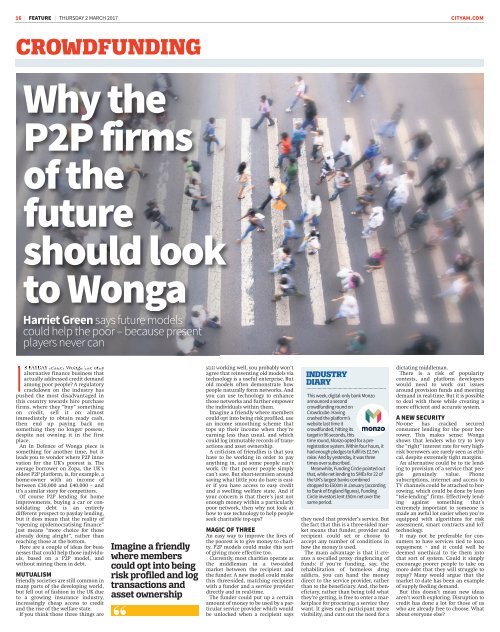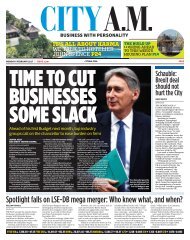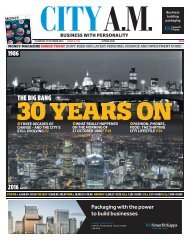IT’S BACK!
cityam-2017-03-02-58b76d1711574
cityam-2017-03-02-58b76d1711574
Create successful ePaper yourself
Turn your PDF publications into a flip-book with our unique Google optimized e-Paper software.
16 FEATURE THURSDAY 2 MARCH 2017<br />
CITYAM.COM<br />
CROWDFUNDING<br />
Why the<br />
P2P firms<br />
of the<br />
future<br />
should look<br />
to Wonga<br />
Harriet Green says future models<br />
could help the poor – because present<br />
players never can<br />
IS PAYDAY lender Wonga the only<br />
alternative finance business that<br />
actually addressed credit demand<br />
among poor people? A regulatory<br />
crackdown on the industry has<br />
pushed the most disadvantaged in<br />
this country towards hire purchase<br />
firms, where they “buy” something<br />
on credit, sell it on almost<br />
immediately to obtain ready cash,<br />
then end up paying back on<br />
something they no longer possess,<br />
despite not owning it in the first<br />
place.<br />
An In Defence of Wonga piece is<br />
something for another time, but it<br />
leads you to wonder where P2P innovation<br />
for the UK’s poorest is. The<br />
average borrower on Zopa, the UK’s<br />
oldest P2P platform, is, for example, a<br />
home-owner with an income of<br />
between £30,000 and £40,000 – and<br />
it’s a similar story for competitors.<br />
Of course P2P lending for home<br />
improvements, buying a car or consolidating<br />
debt is an entirely<br />
different prospect to payday lending,<br />
but it does mean that the reality of<br />
“opening up/democratising finance”<br />
just means “more choice for those<br />
already doing alright”, rather than<br />
reaching those at the bottom.<br />
Here are a couple of ideas for businesses<br />
that could help those individuals,<br />
based on a P2P model, and<br />
without miring them in debt.<br />
MUTUALISM<br />
Friendly societies are still common in<br />
many parts of the developing world,<br />
but fell out of fashion in the UK due<br />
to a growing insurance industry,<br />
increasingly cheap access to credit<br />
and the rise of the welfare state.<br />
If you think those three things are<br />
Imagine a friendly<br />
where members<br />
could opt into being<br />
risk profiled and log<br />
transactions and<br />
asset ownership<br />
still working well, you probably won’t<br />
agree that reinventing old models via<br />
technology is a useful enterprise. But<br />
old models often demonstrate how<br />
people naturally form networks. And<br />
you can use technology to enhance<br />
those networks and further empower<br />
the individuals within them.<br />
Imagine a friendly where members<br />
could opt into being risk profiled, use<br />
an income smoothing scheme that<br />
tops up their income when they’re<br />
earning less than usual, and which<br />
could log immutable records of transactions<br />
and asset ownership.<br />
A criticism of friendlies is that you<br />
have to be working in order to pay<br />
anything in, and some people can’t<br />
work. Or that poorer people simply<br />
can’t save. But short-termism around<br />
saving what little you do have is easier<br />
if you have access to easy credit<br />
and a swelling welfare state. And if<br />
your concern is that there’s just not<br />
enough money within a particularly<br />
poor network, then why not look at<br />
how to use technology to help people<br />
seek charitable top-ups?<br />
MAGIC OF THREE<br />
An easy way to improve the lives of<br />
the poorest is to give money to charity.<br />
P2P models could make this sort<br />
of giving more effective too.<br />
Currently, most charities operate as<br />
the middleman in a two-sided<br />
market between the recipient and<br />
the funder. A new model could make<br />
this three-sided, matching recipient<br />
with a funder and a service provider<br />
directly and in real-time.<br />
The funder could put up a certain<br />
amount of money to be used by a particular<br />
service provider which would<br />
be unlocked when a recipient says<br />
INDUSTRY<br />
DIARY<br />
This week, digital-only bank Monzo<br />
announced a second<br />
crowdfunding round on<br />
Crowdcube. Having<br />
crashed the platform’s<br />
website last time it<br />
crowdfunded, hitting its<br />
target in 96 seconds, this<br />
time round, Monzo opted for a preregistration<br />
system. Within four hours, it<br />
had enough pledges to fulfil its £2.5m<br />
raise. And by yesterday, it was three<br />
times over subscribed.<br />
Meanwhile, Funding Circle pointed out<br />
that, while net lending to SMEs for 22 of<br />
the UK’s largest banks combined<br />
dropped to £500m in January (according<br />
to Bank of England figures), Funding<br />
Circle investors lent £50m net over the<br />
same period.<br />
they need that provider’s service. But<br />
the fact that this is a three-sided market<br />
means that funder, provider and<br />
recipient could set or choose to<br />
accept any number of conditions in<br />
how the money is used.<br />
The main advantage is that it creates<br />
a so-called proxy ringfencing of<br />
funds: if you’re funding, say, the<br />
rehabilitation of homeless drug<br />
addicts, you can hand the money<br />
direct to the service provider, rather<br />
than to the beneficiary. And, the beneficiary,<br />
rather than being told what<br />
they’re getting, is free to enter a marketplace<br />
for procuring a service they<br />
want. It gives each participant more<br />
visibility, and cuts out the need for a<br />
dictating middleman.<br />
There is a risk of popularity<br />
contests, and platform developers<br />
would need to work out issues<br />
around provision funds and meeting<br />
demand in real-time. But it is possible<br />
to deal with these while creating a<br />
more efficient and accurate system.<br />
A NEW SECURITY<br />
No-one has cracked secured<br />
consumer lending for the poor borrower.<br />
This makes sense: Wonga<br />
shows that lenders who try to levy<br />
the “right” interest rate for very highrisk<br />
borrowers are rarely seen as ethical,<br />
despite extremely tight margins.<br />
An alternative could be to tie lending<br />
to provision of a service that people<br />
genuinely value. Phone<br />
subscriptions, internet and access to<br />
TV channels could be attached to borrowing,<br />
which could be done by lean<br />
“tele-lending” firms. Effectively lending<br />
against something that’s<br />
extremely important to someone is<br />
made an awful lot easier when you’re<br />
equipped with algorithms for risk<br />
assessment, smart contracts and IoT<br />
technology.<br />
It may not be preferable for consumers<br />
to have services tied to loan<br />
repayment – and it could well be<br />
deemed unethical to tie them into<br />
that sort of system. Could it simply<br />
encourage poorer people to take on<br />
more debt that they will struggle to<br />
repay? Many would argue that the<br />
market to date has been an example<br />
of supply feeding demand.<br />
But this doesn’t mean new ideas<br />
aren’t worth exploring. Disruption to<br />
credit has done a lot for those of us<br />
who are already free to choose. What<br />
about everyone else?
















